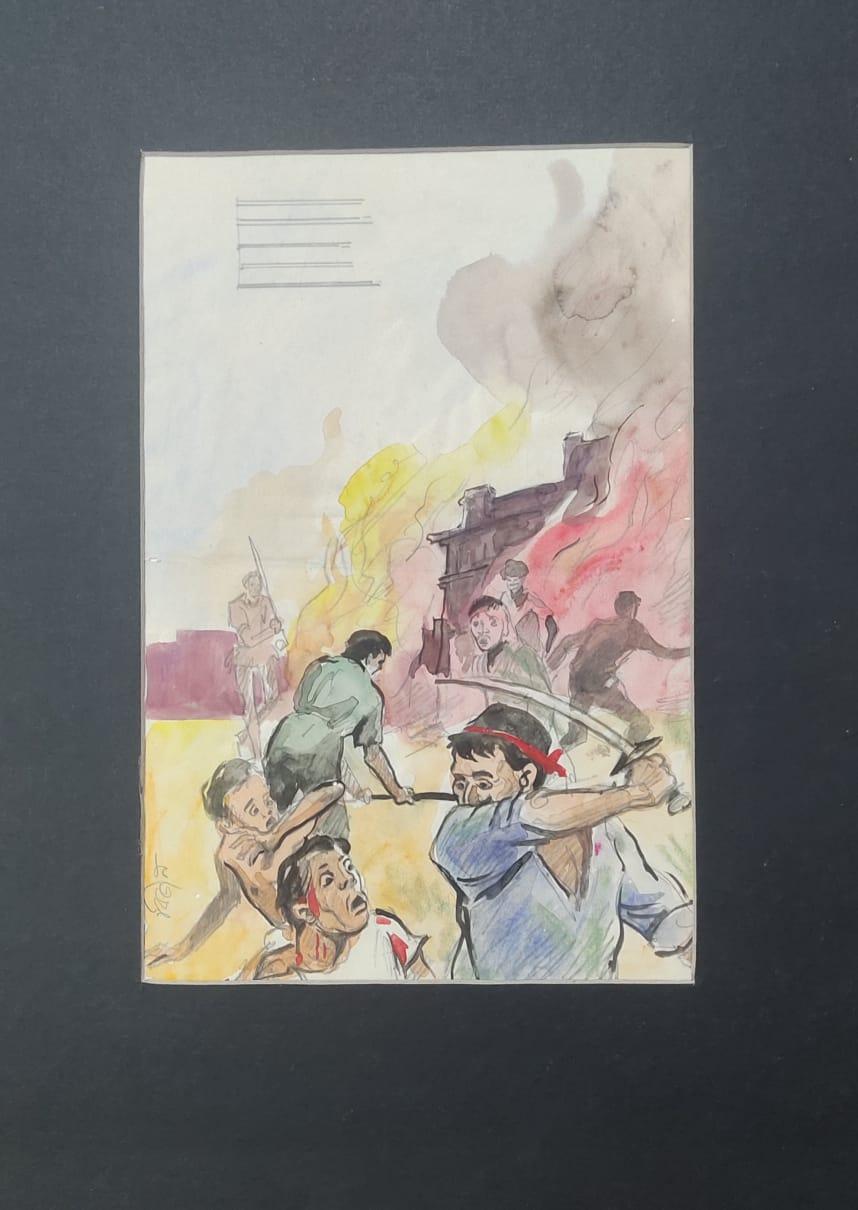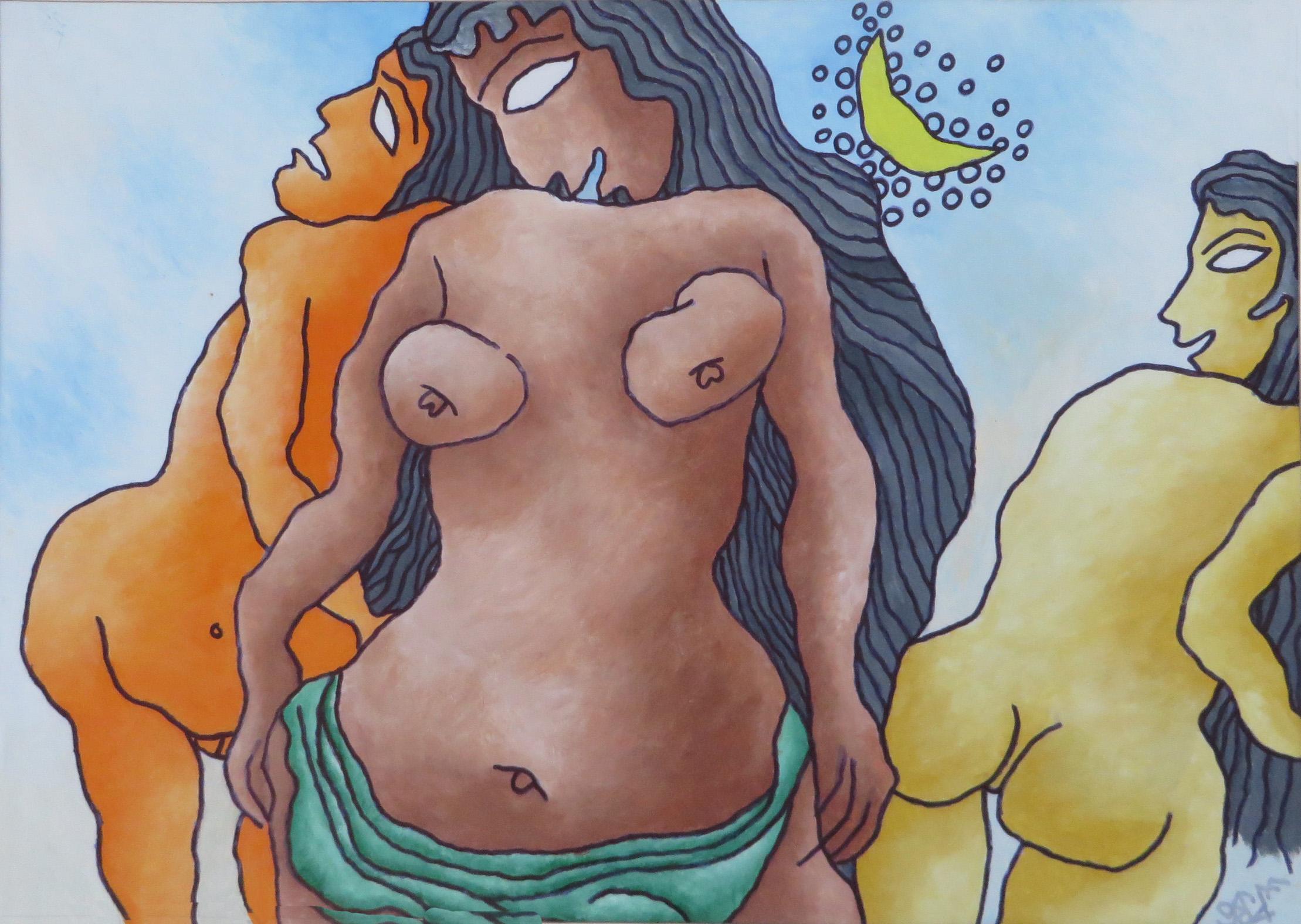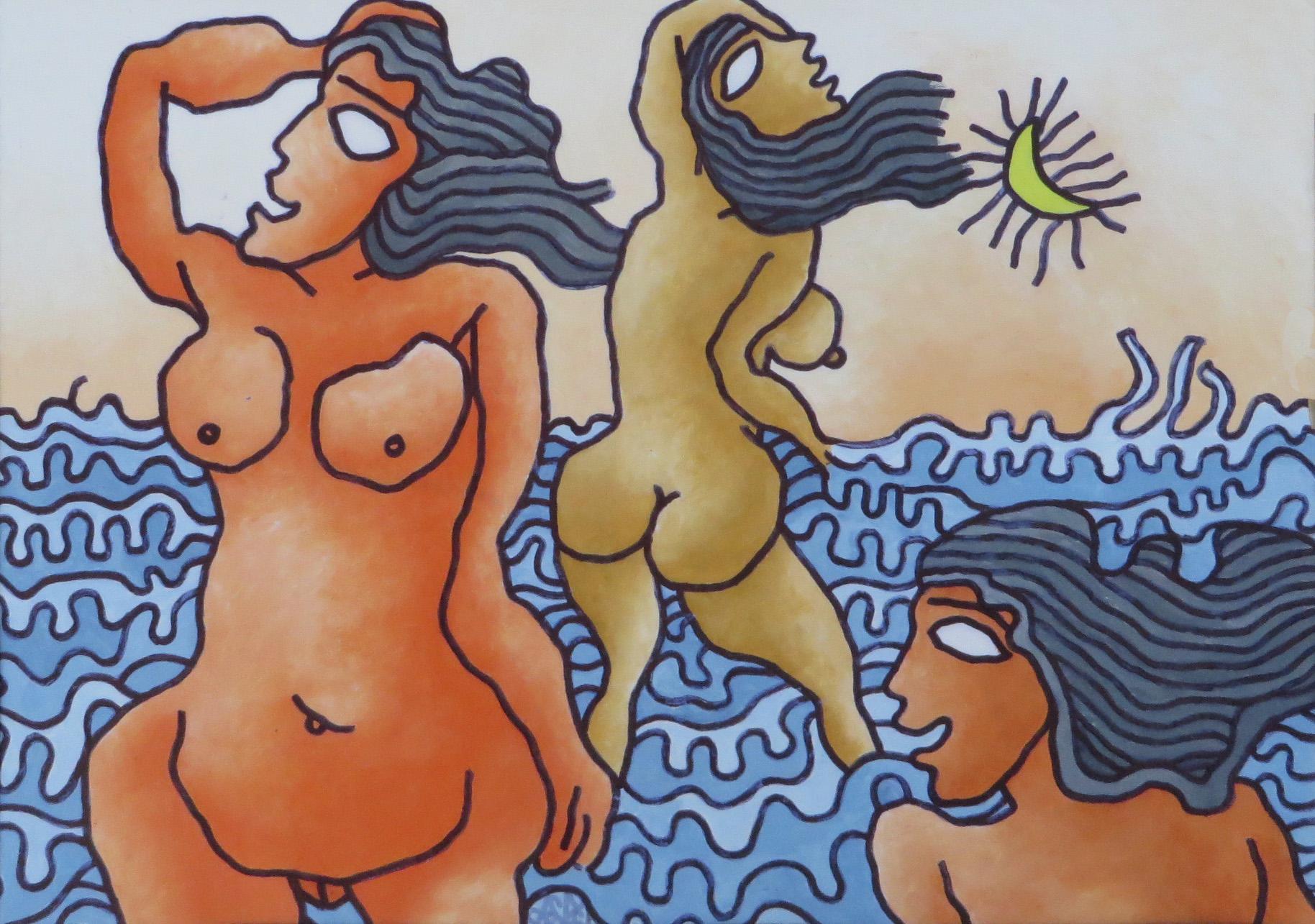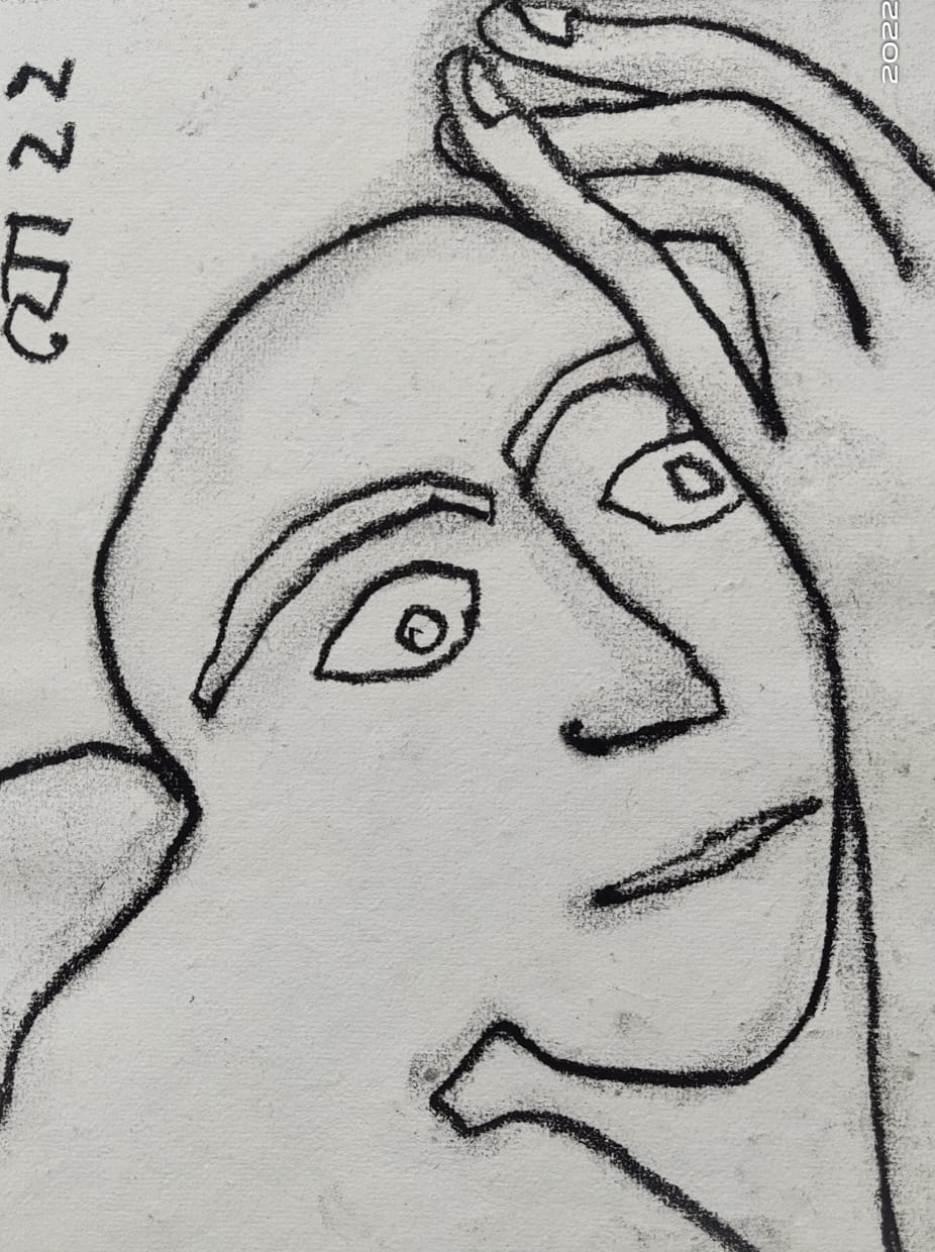Items Similar to Circus Jumpers #2 (Equestrians) mixed media painting by Jon Corbino
Want more images or videos?
Request additional images or videos from the seller
1 of 10
Jon CorbinoCircus Jumpers #2 (Equestrians) mixed media painting by Jon CorbinoCirca 1950
Circa 1950
About the Item
Signed "Corbino" lower left
Inscribed on frame by artist with artist's address in Rockport, MA
Titled by artist on inscription verso.
Provenance: Oelschlaeger Gallery, Chicago, IL. (label verso)
From the artist's July 11, 1964 NYT obituary:
Jon Corbino, painter, whose canvases are represented in 35 museums and galleries, died yesterday at the age of 59.
Mr. Corbino's work, freely described as romantic realism, was characterized by technical skill, vivid color, and scenes of action and movement. Thematically and technically, he was influenced in his early days by the works of DeIacroix and 17century Spanish painters.
He flourished in the nineteenthirties and forties when his dramatic canvases responded to the intellectual climate of those decades. His paintings continued to find many purchasers in the Middle West and Florida until his death.
Commenting on an exhibition of Mr. Corbino's works in 1959, one critic said:
“Romanticism bounds back in Jon Corbino's high spirited circus paintings. Horses and riders, acrobats and dancers perform the liveliest feats in these pictures.
“As compositions they are rather untidily put together, but they show real strength in the representation of movement. Color is, as always with Corbino, warm, pretty, and extremely sweet”
Mr. Corbino was born in Vittorio, Italy, April 3, 1905. At the age of 8 he was brought to the United States, where he attended the Ethical Culture School and the Art Students League here and the Pennsylvania Academy of Fine Arts. He was awarded Guggenheim Fellowships in 1936 and 1937.
Mr. Corbino's forceful, dramatic style won him early recognition and popularity, and oneman shows of his art were given with increased frequency. He received numerous prizes, awards, and medals. Among the museums and galleries that possess Corbino works are the Metropolitan Museum of Art, the Chicago Art Institute, the Whitney Museum, the Brooklyn Museum, the Carnegie Institute and the Brooks Memorial Art Museum in Memphis.
Mr. Corbino is survived by his widow, the former Marcia Norcross, and six children.
- Creator:Jon Corbino (1905 - 1964, American)
- Creation Year:Circa 1950
- Dimensions:Height: 18.5 in (46.99 cm)Width: 24 in (60.96 cm)
- Medium:
- Movement & Style:
- Period:
- Condition:
- Gallery Location:Hudson, NY
- Reference Number:
Jon Corbino
The following is based on information provided by Marcia Corbino, wife of Jon Corbino, and was updated with a publication list by Lee Corbino, daughter of the artist : Jon Corbino, N.A. (1905-1964) A highly acclaimed artist for heroic themes revealing the anxieties of America during the 1930s, Jon Corbino depicted disasters such as wars and floods. These paintings were tributes to the perseverance of man against unknown forces of the universe. He was much admired for his skill in draftsmanship and brilliant, smoldering colors. He was also known for his love of horses, sometimes painting these powerful animals as mythic symbols from the Greek legends of the childhood. In addition, he painted the fantasy of the circus and the ballet, often from back stage where the performers were captured in a reflective moment. Jon Corbino was born in Vittoria, Sicily in 1905 and came to the United States with his parents at the age of 8. He grew up in New York City and attended the Ethical Culture Fieldston School on an art scholarship and then enrolled in the Art Students League. He received two Guggenheim Fellowships and was elected a member of the National Academy of Design in 1940. In 1941, he received the first grant awarded to a visual artist from the National Institute of Arts and Letters. The poet Stephen Vincent Benet made the presentation at Carnegie Hall, and in his commendation said that Corbino "has brought to American art rare gifts of color and design, and because of the honesty, richness and variety of his work." Corbino's work was also featured in three Venice Biennales. In 1966, a critic for the Chicago American wrote of a Corbino retrospective exhibition: "he painted people of the world-people on the beach, in the sun, in the moonlight. But he graced them with spirit, life, and movement that transcend the everyday." His work is represented in 64 U.S. museums as well as the Lotus Club, New York, NY; First National Bank of Chicago; Fine Arts Society, Sarasota, FL; Hallmark Cards, Inc., Kansas City, MO; Ringling College of Art and Design, Sarasota, FL; Georgetown University Library, Washington, D.C.; The United States Post Office, Long Beach, Long Island, NY; Town of Rockport, Massachusetts, Rockport, MA.
About the Seller
5.0
Vetted Seller
These experienced sellers undergo a comprehensive evaluation by our team of in-house experts.
Established in 1973
1stDibs seller since 2023
6 sales on 1stDibs
Typical response time: 1 hour
- ShippingRetrieving quote...Ships From: Hudson, NY
- Return PolicyThis item cannot be returned.
More From This SellerView All
- On the Beach modernist oil painting by Byron BrowneBy Byron BrowneLocated in Hudson, NYByron Browne On the Beach (1959) Oil on canvas, 20" x 26" 26" x 32" x 1" frame size - likely original Inscribed verso "On the Beach / 1959 / Byron Browne" Provenance: Private collection, Berkley, California About this artist: Through an oeuvre displaying the re-envisioning of figural subjects and the formation of an abstract expressionist style, Byron Browne stands out among the American abstractionists of his generation. Born in Yonkers, New York, in 1907, the artist was a bright talent at the National Academy of Design in his teens. From 1924 to 1928 Browne studied at the Academy under notable artists Robert Aitkin, Charles Courtney Curran, Charles Hawthorne, Alice Murphy...Category
Mid-20th Century Modern Figurative Paintings
MaterialsOil, Canvas
- Inevitable Day – Birth of the Atom oil and tempera painting by Julio De DiegoBy Julio de DiegoLocated in Hudson, NYJulio De Diego’s Atomic Series paintings made an extraordinary statement regarding the shock and fear that accompanied the dawn of the nuclear age. In the artist’s own words, “Scientists were working secretly to develop formidable powers taken from the mysterious depths of the earth - with the power to make the earth useless! Then, the EXPLOSION! . . . we entered the Atomic Age, and from there the neo-Atomic war begins. Explosions fell everywhere and man kept on fighting, discovering he could fight without flesh.” To execute these works, De Diego developed a technique of using tempera underpainting before applying layer upon layer of pigmented oil glazes. The result is paintings with surfaces which were described as “bonelike” in quality. The forms seem to float freely, creating a three-dimensional visual effect. In the 1954 book The Modern Renaissance in American Art, author Ralph Pearson summarizes the series as “a fantastic interpretation of a weighty theme. Perhaps it is well to let fantasy and irony appear to lighten the devastating impact. By inverse action, they may in fact increase its weight.” Bibliography Art in America, April 1951, p.78 About this artists: Julio De Diego crafted a formidable persona within the artistic developments and political struggles of his time. The artist characterized his own work as “lyrical,” explaining, “through the years, the surrealists, the social-conscious painters and the others tried to adopt me, but I went my own way, good, bad or indifferent.” [1] His independence manifested early in life when de Diego left his parent’s home in Madrid, Spain, in adolescence following his father’s attempts to curtail his artistic aspirations. At the age of fifteen he held his first exhibition, set up within a gambling casino. He managed to acquire an apprenticeship in a studio producing scenery for Madrid’s operas, but moved from behind the curtains to the stage, trying his hand at acting and performing as an extra in the Ballet Russes’ Petrouchka with Nijinsky. He spent several years in the Spanish army, including a six-month stretch in the Rif War of 1920 in Northern Africa. His artistic career pushed ahead as he set off for Paris and became familiar with modernism’s forays into abstraction, surrealism, and cubism. The artist arrived in the U.S. in 1924 and settled in Chicago two years later. He established himself with a commission for the decoration of two chapels in St. Gregory’s Church. He also worked in fashion illustration, designed magazine covers and developed a popular laundry bag for the Hotel Sherman. De Diego began exhibiting through the Art Institute of Chicago in 1929, and participated in the annual Chicago Artists Exhibitions, Annual American Exhibitions, and International Water Color Exhibitions. He held a solo exhibition at the Art Institute of Chicago in the summer of 1935. Though the artist’s career was advancing, his family life had deteriorated. In 1932 his first marriage dissolved, and the couple’s young daughter Kiriki was sent to live with friend Paul Hoffman. De Diego continued to develop his artistic vocabulary with a growing interest in Mexican art. He traveled throughout the country acquainting himself with the works of muralists such as Carlos Merida, and also began a collection of small native artifacts...Category
1940s American Modern Abstract Paintings
MaterialsMasonite, Oil, Tempera
- The Magician oil and tempera painting by Julio de DiegoBy Julio de DiegoLocated in Hudson, NYJulio De Diego’s Atomic Series paintings made an extraordinary statement regarding the shock and fear that accompanied the dawn of the nuclear age. In the artist’s own words, “Scientists were working secretly to develop formidable powers taken from the mysterious depths of the earth - with the power to make the earth useless! Then, the EXPLOSION! . . . we entered the Atomic Age, and from there the neo-Atomic war begins. Explosions fell everywhere and man kept on fighting, discovering he could fight without flesh.” To execute these works, De Diego developed a technique of using tempera underpainting before applying layer upon layer of pigmented oil glazes. The result is paintings with surfaces which were described as “bonelike” in quality. The forms seem to float freely, creating a three-dimensional visual effect. In the 1954 book The Modern Renaissance in American Art, author Ralph Pearson summarizes the series as “a fantastic interpretation of a weighty theme. Perhaps it is well to let fantasy and irony appear to lighten the devastating impact. By inverse action, they may in fact increase its weight.” Exhibited 1964 Marion Koogler McNay Art Institute, San Antonio, Texas This work retains its original frame which measures 54" x 42" x 2" About this artist: Julio De Diego crafted a formidable persona within the artistic developments and political struggles of his time. The artist characterized his own work as “lyrical,” explaining, “through the years, the surrealists, the social-conscious painters and the others tried to adopt me, but I went my own way, good, bad or indifferent.” [1] His independence manifested early in life when de Diego left his parent’s home in Madrid, Spain, in adolescence following his father’s attempts to curtail his artistic aspirations. At the age of fifteen he held his first exhibition, set up within a gambling casino. He managed to acquire an apprenticeship in a studio producing scenery for Madrid’s operas, but moved from behind the curtains to the stage, trying his hand at acting and performing as an extra in the Ballet Russes’ Petrouchka with Nijinsky. He spent several years in the Spanish army, including a six-month stretch in the Rif War of 1920 in Northern Africa. His artistic career pushed ahead as he set off for Paris and became familiar with modernism’s forays into abstraction, surrealism, and cubism. The artist arrived in the U.S. in 1924 and settled in Chicago two years later. He established himself with a commission for the decoration of two chapels in St. Gregory’s Church. He also worked in fashion illustration, designed magazine covers and developed a popular laundry bag for the Hotel Sherman. De Diego began exhibiting through the Art Institute of Chicago in 1929, and participated in the annual Chicago Artists Exhibitions, Annual American Exhibitions, and International Water Color Exhibitions. He held a solo exhibition at the Art Institute of Chicago in the summer of 1935. Though the artist’s career was advancing, his family life had deteriorated. In 1932 his first marriage dissolved, and the couple’s young daughter Kiriki was sent to live with friend Paul Hoffman. De Diego continued to develop his artistic vocabulary with a growing interest in Mexican art. He traveled throughout the country acquainting himself with the works of muralists such as Carlos Merida, and also began a collection of small native artifacts...Category
1940s American Modern Abstract Paintings
MaterialsMasonite, Oil, Tempera
- St. Atomic oil and tempera painting by Julio de DiegoBy Julio de DiegoLocated in Hudson, NYJulio De Diego’s Atomic Series paintings made an extraordinary statement regarding the shock and fear that accompanied the dawn of the nuclear age. In the artist’s own words, “Scientists were working secretly to develop formidable powers taken from the mysterious depths of the earth - with the power to make the earth useless! Then, the EXPLOSION! . . . we entered the Atomic Age, and from there the neo-Atomic war begins. Explosions fell everywhere and man kept on fighting, discovering he could fight without flesh.” To execute these works, De Diego developed a technique of using tempera underpainting before applying layer upon layer of pigmented oil glazes. The result is paintings with surfaces which were described as “bonelike” in quality. The forms seem to float freely, creating a three-dimensional visual effect. In the 1954 book The Modern Renaissance in American Art, author Ralph Pearson summarizes the series as “a fantastic interpretation of a weighty theme. Perhaps it is well to let fantasy and irony appear to lighten the devastating impact. By inverse action, they may in fact increase its weight.” Exhibited 1950 University of Illinois at Urbana "Contemporary American Painting" 1964 Marion Koogler McNay Art Institute, San Antonio, Texas This work retains its original frame which measures 54" x 36" x 2". About this artist: Julio De Diego crafted a formidable persona within the artistic developments and political struggles of his time. The artist characterized his own work as “lyrical,” explaining, “through the years, the surrealists, the social-conscious painters and the others tried to adopt me, but I went my own way, good, bad or indifferent.” [1] His independence manifested early in life when de Diego left his parent’s home in Madrid, Spain, in adolescence following his father’s attempts to curtail his artistic aspirations. At the age of fifteen he held his first exhibition, set up within a gambling casino. He managed to acquire an apprenticeship in a studio producing scenery for Madrid’s operas, but moved from behind the curtains to the stage, trying his hand at acting and performing as an extra in the Ballet Russes’ Petrouchka with Nijinsky. He spent several years in the Spanish army, including a six-month stretch in the Rif War of 1920 in Northern Africa. His artistic career pushed ahead as he set off for Paris and became familiar with modernism’s forays into abstraction, surrealism, and cubism. The artist arrived in the U.S. in 1924 and settled in Chicago two years later. He established himself with a commission for the decoration of two chapels in St. Gregory’s Church. He also worked in fashion illustration, designed magazine covers and developed a popular laundry bag for the Hotel Sherman. De Diego began exhibiting through the Art Institute of Chicago in 1929, and participated in the annual Chicago Artists Exhibitions, Annual American Exhibitions, and International Water Color Exhibitions. He held a solo exhibition at the Art Institute of Chicago in the summer of 1935. Though the artist’s career was advancing, his family life had deteriorated. In 1932 his first marriage dissolved, and the couple’s young daughter Kiriki was sent to live with friend Paul Hoffman. De Diego continued to develop his artistic vocabulary with a growing interest in Mexican art. He traveled throughout the country acquainting himself with the works of muralists such as Carlos Merida, and also began a collection of small native artifacts...Category
1940s American Modern Abstract Paintings
MaterialsMasonite, Oil, Tempera
- The Lonely Road by William Charles PalmerLocated in Hudson, NYThe Lonely Road (1940) Tempera on panel 12" x 16" 19 1/2" x 23 1/2" x 1 1/2" framed Hand-signed "Palmer '40" lower center. Provenance: Midtown Galleries, New York, NY (labels verso...Category
Mid-20th Century American Modern Figurative Paintings
MaterialsPanel, Tempera
- Fish Story oil painting by Williams Charles PalmerLocated in Hudson, NYThis painting is illustrated in the Catalogue of the 1945 Encyclopedia Britannica Collection of Contemporary American Painting, p.84. Written and edited by Grace Pagano. "Painting ...Category
Mid-20th Century American Modern Figurative Paintings
MaterialsOil, Canvas
You May Also Like
- Radha, Mixed Media on Board, (Set of 2 works) by Artist Suhas Roy "In Stock"By Suhas RoyLocated in Kolkata, West BengalSuhas Roy Radha (a) Mixed Media on Board, 5.4 x 5.6 inches, 2009 (b) Mixed Media on Board, 4.8 x 6 inches, 2006 Suhas Roy 's mystic woman which he calls 'Radha', either Oil on canva...Category
Early 2000s Modern Figurative Paintings
MaterialsPaper, Mixed Media
- Untitled, Mixed Media on Paper, Red, Yellow by Modern Indian Artist "In Stock"By Bijan ChoudhuryLocated in Kolkata, West BengalBijan Choudhury - Untitled - 7.6 x 10.6 inches (unframed size) Mixed Media on Paper ( UNFRAMED ALL IN DOOR DELIVERED ) Style : The Marxist orienta...Category
Early 2000s Modern Figurative Paintings
MaterialsPaper, Mixed Media
- At night. 1961. Paper, mixed media, 14x10 cmLocated in Riga, LVAt night. 1961. Paper, mixed media, 14x10 cm Adolfs Zardins (1890 08 II Riga, Latvia – 1967 07 II Jurmala, Latvia), painter. Only in 1990 his relatives give his artistic heritage to...Category
1960s Modern Portrait Paintings
MaterialsPaper, Ink, Mixed Media, Watercolor
- Beach Series Mixed Media on Paper by Modern Artist Prokash Karmakar "In Stock"By Prakash KarmarkarLocated in Kolkata, West BengalPrakash Karmakar - Beach Series - 16 x 23 inches (unframed size) Mixed Media on Paper , 2004 Style : Legendary master artist Lt. Prokash Karmakar from Bengal was solely responsible ...Category
Early 2000s Modern Figurative Paintings
MaterialsMixed Media, Paper
- Beach Series Mixed Media on Paper by Modern Artist Prokash Karmakar "In Stock"By Prakash KarmarkarLocated in Kolkata, West BengalPrakash Karmakar - Beach Series - 16 x 23 inches (unframed size) Mixed Media on Paper , 2004 Style : Legendary master artist Lt. Prokash Karmakar from Bengal was solely responsible ...Category
Early 2000s Modern Figurative Paintings
MaterialsMixed Media, Paper
- Sleepless Night, Dry Pastel on Paper by Artist Jogen Chowdhury "In StockBy Jogen ChowdhuryLocated in Kolkata, West BengalJogen Chowdhury Sleepless Night, Dry Pastel on Paper 7 x 9.25 inches , 2022 The work will be shipped inclusive of framing. Signed in Bengali Style : He has immense contribution in inspiring young artists of India. Jogen Chowdhury had developed his individual style after his return from Paris. His most famous paintings are in ink, watercolor and pastel. He has painted in oil medium as well. In Chowdhury’s more recent works the sensory experiences of cloth, bolsters, sofas and the human body are cross-projected to produce an uncanny world of tran-substantiated tumescence and flaccidness. Jogen Chowdhury has been widely acknowledged to be, the master of the unbroken line. Like Léger, Chowdhury has been stirred by the linear Kalighat pat tradition, but his lines are emotive and used to express and suggest the character of a person. This is done by, distorting the form without breaking the line and in the world of young, contemporary art; distortion has been Jogen Chowdhury’s most significant impact. Perhaps, because of this, a common observation of his work is that his “people” are caricatures. The person feels familiar to the viewer but it is far more individualised – the face is imaginary but the psyche or characteristics are real. The power and beauty of his technique and line is this play between the known and unknown. In Jogen Chowdhury’s work, the figure is always in the foreground, it is primary, it conveys everything. He uses colour to give volume to his figures and the fluidity of his lines bring a sensual aspect to his forms. About the Artist and his work : Born : Born 1939 in Daharpara Village, Faridpur, Bangladesh. Jogen Chowdhury is an eminent Indian painter and considered an important painter of 21st century India. Family Background : His father Pramatnath Chowdhury was a Brahmin zamindar. Both his parents took interest in art, Jogen Chowdhury’s father Pramatnath Chowdhury painted several mythological scenes from the village theatres and also sculpted various Hindu icons. Whereas his mother was an expert in Alpana drawings. 1939-47 Jogen Chowdhury lived in a village atmosphere. And after partition in 1948, the whole family shifted. Till 1951 the whole family stayed at the police department quarter of his uncle, where on the walls Jogen Chowdhury painted his first painting, 1962 Jogen Chowdhury was employed as Designer in the Handloom Board. Education : 1955-60: Studied at the Government College of Art and Crafts, Kolkata. 1965 : He went to paris to study in Ecole des Beaux Arts, in William Hayter’s Atelier 17. Professional Experience : 1968-72 : He worked as an Art-Designer, Madras Handloom Board, Madras. 1970 : A collection of his poems were published, titled ‘Hridoy Train Beje Othey’. 1987 : Joined Kala Bhavan , Santiniketan as a professor of painting. Selected Exhibitions : 1972, 1975 & 1978 respectively : I, III, IV Triennales at New Delhi. 1979: The Sao Paolo Biennale. 1980: The exhibitions at the Fukuoka Museum, Japan. 1982: The Royal Academy, London. 1982: The Hirschhorn Museum, Washington D.C. 1986: The II Havana Biennale. 1989: ‘Festival of India’, in Geneva. 2002: Saffron art...Category
2010s Modern Mixed Media
MaterialsPaper, Pastel, Mixed Media
Recently Viewed
View AllMore Ways To Browse
Dior West
3 Children Painting
Vintage Warmer 2
Romanticism Painting
Memphis Paintings
Retro Circus Art
Man With Horse Painting
Vintage Dance Moves
Vintage Circus Painting
Man And Horse Painting
Vintage Circus Signs
Early 20th Century Realism Paintings
Circus Canvas
Horse Painting Italian
Rockport Artists
Modern Equestrian
Spanish Dancer Painting
Spanish Dancing Painting






